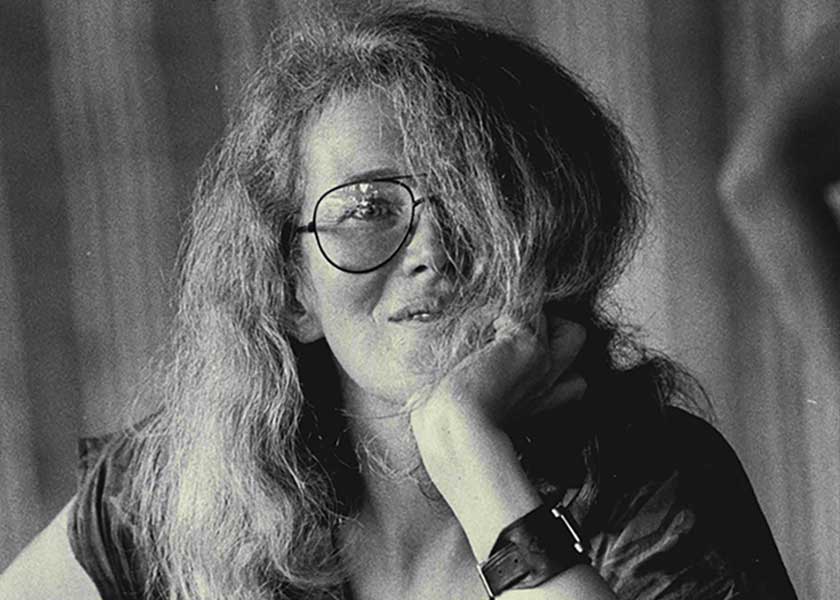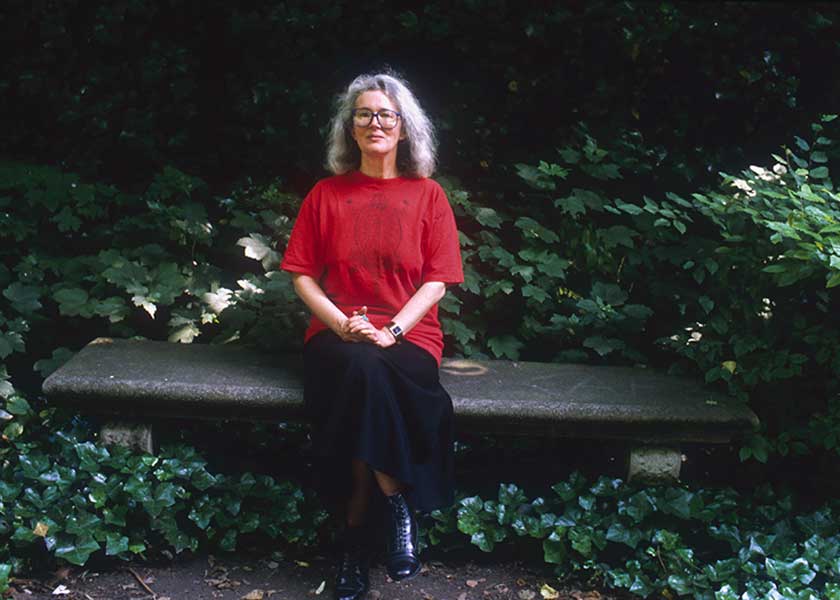- Home |
- Search Results |
- The much-missed vitality of Angela Carter

This week, Angela Carter would have turned 80. The author, known for novels such as Wise Children and collections of short stories including The Bloody Chamber and Fireworks, died in 1992, from lung cancer when she was 51. Carter’s work was dark and subversive, twisted and exploratory and weird. It was often termed ‘magical realism’, dealing as it did with fairy tales and anthropomorphism, inexplicable transformations between man and beast and strange, other metamorphoses. But Carter rejected that term, calling her writing ‘more realism than not.’
It’s curious to think of her being 80, a contemporary of those other grand, outspoken doyennes of literature – Toni Morrison, who died last year; Alice Munro; Margaret Atwood. One wonders if she would have a Twitter account, and what she would post on it. After all, Carter documented certain periods of her life meticulously. A letter-writer, she wrote them nearly every day while living in Japan, explaining in one of them that her ‘life had become like a cheap novel’.
Carter’s life was like something out of her books. Its documented best in The Invention of Angela Carter: A Biography, written by Edmund Gordon in 2016, but a brief recap would touch upon a strange and cosseted childhood under a mother who was so protective she could barely go to the bathroom alone. Before she was out of her teens, Carter met her husband, a folk singer who gave her his surname. Within a decade, she used funds from a writing prize to abandon him and move to Tokyo, where she took in young-looking men and examined life by looking in lieu of understanding the language. It was this time, she wrote, that she started ‘my own questioning of the nature of my reality as a woman. How that social fiction of my “femininity” was created.’
'I suspect she would not agree with Germaine Greer currently'
Carter’s feminism is crucial to her legacy. She left the Seventies in a blazing, controversial trail of it, with both non-fiction work The Sadiean Woman and the Ideology of Pornography (hated by Andrea Dworkin and other second-wave feminists) and The Bloody Chamber (which became a near-instant set text).
‘Her feminism was actually much closer to that we see now than it was to many of her contemporaries,’ Gordon tells me. ‘She upset a lot of feminist writers. She didn’t believe that many differences between men and women were due to the biological fact of sexual differentiation, she thought they were societal impositions.’ I posit that her views would be intriguing in the current socio-political hot potato of trans rights, and Gordon agrees. ‘I suspect she would not agree with Germaine Greer currently.’
Gender was something that Carter made as slippery as the barriers between the real and the ethereal in her work. In The Passion of New Eve, her 1977 novel, a man becomes a woman in a dystopian America. In The Bloody Chamber, beasts are transformed into men by touch, and women into beasts by similar encounters.

‘Carter’s inversions of stories like Beauty and the Beast gave us a new folklore,’ Anne Enright tells me. The Irish author studied under Carter during her creative writing MA, but it was Carter’s books that inspired her to take the course ( ‘I have some paperbacks of Carter’s work on my shelves. When I check inside, I see that even my signature has changed - I was that young’).
‘I don’t think it is too much to say that the influence of The Bloody Chamber is everywhere now, especially in children’s fiction,’ she continues. ‘The victories of various princesses over the stupidities of their fathers and suitors were a commonplace in the picture books I read to my children, 15 years ago. They have gone altogether mainstream in the heroic princesses of Pixar and Disney. If you ask me, the makers of Frozen should have put her name in the credits.’
And beyond, too. While Carter’s influence on literature is ‘everywhere’, says Gordon, the rest of art is not immune. The Brit Award-winning indie band Wolf Alice borrowed their name from the collection’s interpretation of Red Riding Hood. The Chamber has been adapted for television, film and stage. If you’ve studied English Literature at an undergraduate level over the past couple of decades, you will have encountered The Bloody Chamber. It’s led, Gordon believes, to an awkward association with Carter: ‘I think she would have been horrified by some of the things that claim a Carter-esque influence,’ he says. ‘That sort of, Disneyfication of fairytales in cinema which I don’t think she’d want any responsibility for.’
Later in her short life, Carter admitted to being surprised by The Bloody Chamber’s grisly contents – in the mid-Eighties, she commented: ‘You know, sometimes when I read my back pages, I’m quite appalled at the violence of my imagination. Before I had a family and stuff.’
'Just as she was coming into her own, in all sorts of ways, the fairytale was cut short'
Carter found a kind of domestic harmony in her forties, when she had a son with Mark Pearce, a plumber 15 years her junior with whom she was instantly besotted (she claimed he looked like a werewolf). Their household was one of bohemians and languorous meals – Enright was invited for lunch, but too scared to take Carter up on the offer. This was the Eighties, and while the two novels she wrote during the decade, Nights at the Circus and Wise Children, weren’t Booker Prize-nominated, their omission from the shortlists was roundly noticed.
‘The shape of her life is very poignant,’ says Gordon. ‘Just as she was coming into her own, in all sorts of ways, the fairytale was cut short.’ Carter was elected as a fellow of the Royal Society of Literature the year she died. Wise Children, her final novel, was also the book that sold best during her life. ‘Her moment was coming. Some of her ideas, the books she had been writing for ages and her openness to pulp genres were becoming trendy in the Nineties.’
Carter was, in short, ahead of her time. Her death only made her work more pertinent, more fascinating: in the year after she died, there were more applications of funding for doctoral research on her work than on that produced during the entirety of the 18th century. And it’s an interest that has only grown since, in television documentaries and books and films.